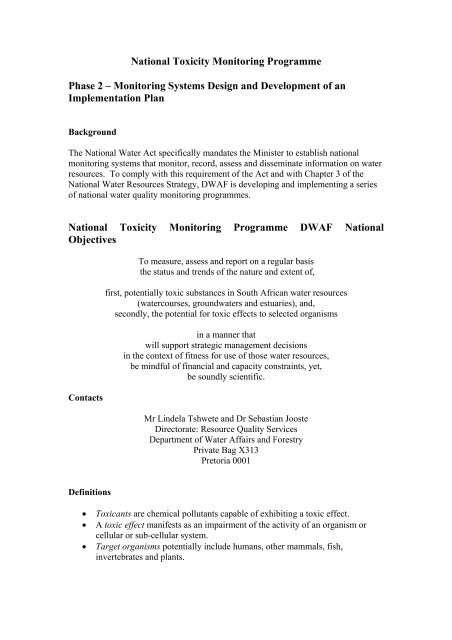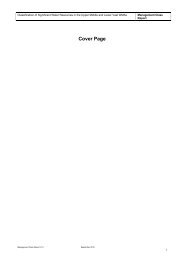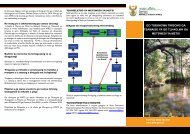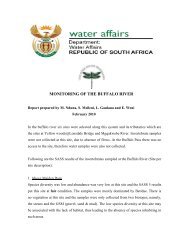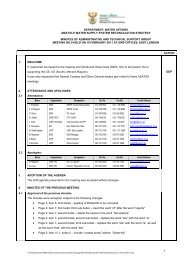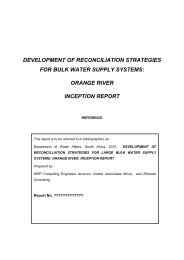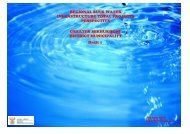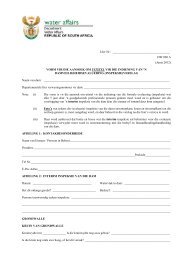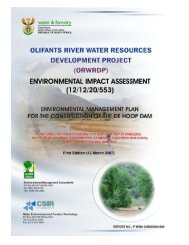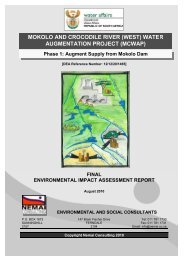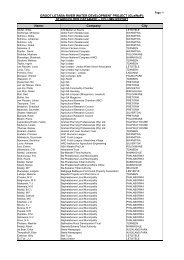National Toxicant Monitoring Programme - DWA Home Page
National Toxicant Monitoring Programme - DWA Home Page
National Toxicant Monitoring Programme - DWA Home Page
You also want an ePaper? Increase the reach of your titles
YUMPU automatically turns print PDFs into web optimized ePapers that Google loves.
<strong>National</strong> Toxicity <strong>Monitoring</strong> <strong>Programme</strong><br />
Phase 2 – <strong>Monitoring</strong> Systems Design and Development of an<br />
Implementation Plan<br />
Background<br />
The <strong>National</strong> Water Act specifically mandates the Minister to establish national<br />
monitoring systems that monitor, record, assess and disseminate information on water<br />
resources. To comply with this requirement of the Act and with Chapter 3 of the<br />
<strong>National</strong> Water Resources Strategy, <strong>DWA</strong>F is developing and implementing a series<br />
of national water quality monitoring programmes.<br />
<strong>National</strong> Toxicity <strong>Monitoring</strong> <strong>Programme</strong> <strong>DWA</strong>F <strong>National</strong><br />
Objectives<br />
Contacts<br />
Definitions<br />
To measure, assess and report on a regular basis<br />
the status and trends of the nature and extent of,<br />
first, potentially toxic substances in South African water resources<br />
(watercourses, groundwaters and estuaries), and,<br />
secondly, the potential for toxic effects to selected organisms<br />
in a manner that<br />
will support strategic management decisions<br />
in the context of fitness for use of those water resources,<br />
be mindful of financial and capacity constraints, yet,<br />
be soundly scientific.<br />
Mr Lindela Tshwete and Dr Sebastian Jooste<br />
Directorate: Resource Quality Services<br />
Department of Water Affairs and Forestry<br />
Private Bag X313<br />
Pretoria 0001<br />
• <strong>Toxicant</strong>s are chemical pollutants capable of exhibiting a toxic effect.<br />
• A toxic effect manifests as an impairment of the activity of an organism or<br />
cellular or sub-cellular system.<br />
• Target organisms potentially include humans, other mammals, fish,<br />
invertebrates and plants.
Study Team<br />
Name Task Phone no E-mail<br />
Dr Ralph Heath Project coordinator<br />
Leader of task 3<br />
011 726 7027 ralphh@phd.co.za<br />
Dr Kevin Leader of tasks 7, 012 998 4059 kmurray@mweb.co.za<br />
Murray 8, 9 and 11<br />
Laetitia Slabbert Leader of tasks 6 012 8413953 LSlabber@csir.co.za<br />
Petrus Matji Leader of task 4 mpmatji@mweb.co.za<br />
Bennie<br />
Haasbroek<br />
Leader of tasks 2 012 3368360 haasbroekb@dwaf.gov.za<br />
Ansie Burger Leader of tasks 10 027 4822246 ansie_burger@hotmail.com<br />
Carl Schoeman Leader of tasks 5 016 421 5150 cschoema@randwater.co.za<br />
Dr P Kempster <strong>DWA</strong>F 012 808 0374 Kempsterp@dwaf.gov.za<br />
Dr S Jooste <strong>DWA</strong>F 012 808 0374 joosteS@dwaf.gov.za<br />
Dr A Kuhn <strong>DWA</strong>F 012 808 0374 kuhna@dwaf.gov.za<br />
B.Madikizela <strong>DWA</strong>F 012 808 0374 madikib@dwaf.gov.za<br />
L Tshwete <strong>DWA</strong>F 012 808 0374 tshwetel@dwaf.gov.za<br />
Project deliverables<br />
The ultimate aim of the project for which this proposal is submitted is to execute<br />
selected tasks required for the prototype design of the national toxicants monitoring<br />
programme. Each task will be executed in such a way that it complements the<br />
remaining design considerations to form a complete practical and cost-effective<br />
prototype monitoring design that can be tested in a series of pilot studies.<br />
Specific objectives of these tasks addressed in this proposal are as follows:<br />
Work schedule<br />
No. TASK<br />
1 Project co-ordination<br />
2 Overall design framework<br />
3 <strong>Monitoring</strong> variable selection<br />
4 <strong>Monitoring</strong> site selection<br />
5 Data generation (WRC funded)<br />
6 Sampling and analysis methodology<br />
7 Data management<br />
8 Data assessment and reporting protocols<br />
9 Quality assurance and control<br />
10 Capacity building plan (WRC funded)<br />
11 Research report and prototype implementation manual<br />
The project is scheduled to start in the last quarter of 2003 and to be completed in the<br />
third quarter of 2005.
Task Quarter: 1 2 3 4 5 6 7 8<br />
Project<br />
co-ordination<br />
Overall<br />
design framework<br />
<strong>Monitoring</strong> variable selection<br />
<strong>Monitoring</strong><br />
site selection<br />
Sampling and analysis<br />
methodology<br />
Data<br />
management<br />
Data assessment and reporting<br />
protocols<br />
Quality assurance and control<br />
Research Report &<br />
implementation manual<br />
Dates of meetings:<br />
The following are dates for Project Management meetings:<br />
17 Sep 09h00 at RQS<br />
18 Oct 09h00 at RQS<br />
22 Nov 09h00 at RQS<br />
Next project team workshop is 13 Sep 09h00 at RQS


